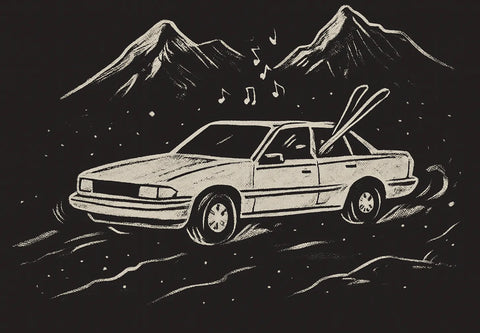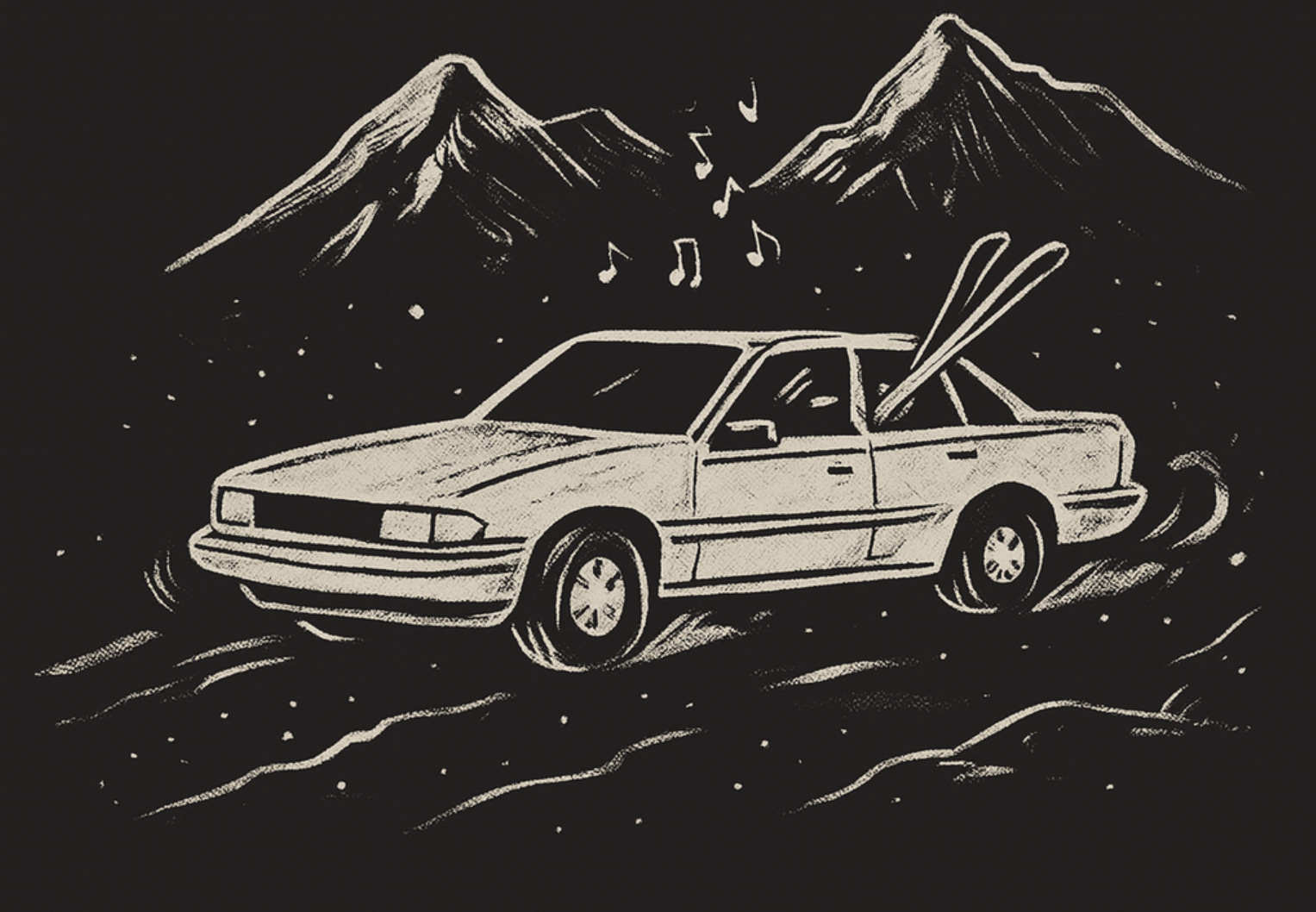
Remember When We Used to Own Things?
The concept of practice is an integral aspect of being human: doing something repeatedly, making errors and learning from them, operating at the edges of your ability, and, most valuable of all, the satisfaction gained from improvement.
Practice is more than just the repetition of behaviour; it's a movement of energy that creates a fissure within us to reveal what's within. More movement, more revelation. Among the many things we discover about ourselves when engaged in the practice of writing, dance, making things or making music is how to live with meaning and intention, which is perhaps the most important discovery of all.
In 1999, Nicola and I were practising being adults in the most tactile way possible. We packed everything we owned into two oversized backpacks and flew to Vancouver to spend the winter as ski instructors on Grouse Mountain. We were 23, madly in love for all of eighteen months, and convinced we could figure out life one season at a time through the simple practice of showing up.
We rented a room in a shared house on the corner of 4th Street & Lonsdale in North Vancouver with three other ski instructors - Stefan, Sarah, and Jake. The kind of friends who measured success by powder days (who still do) and tip money, who are still some of our closest friends thirty years later. Our routine was simple: teach tourists how to snow plough during the day, then explore our new city at night!
Vancouver in the late 90s felt like the edge of the world. Starbucks was still cozy back then, with actual couches and an atmosphere that made you want to linger. Seattle's Best Coffee and Second Cup were the challenger brands, each trying to carve out their piece of the caffeine revolution. We'd spend hours in these places, planning adventures we couldn't afford and dreaming about the road trip we were saving for.
On our second day off, wandering through North Vancouver's small downtown, we discovered a record store tucked below street level. You had to walk down steep, narrow stairs lit by a single red bulb that made everything feel like entering a speakeasy. The smell hit you first - that mix of vinyl, cardboard, and something indefinable that all good record stores seem to share.
We spent an hour flicking through CDs, practising the art of discovery. Three albums caught our attention: Bush's "X" (renamed in Canada due to licensing issues), Matthew Good Band, and Nicola's pick, Marcy Playground. Thirty-something dollars for three complete worlds we could hold in our hands, study, and make our own through repeated listening, through mistakes in interpretation, through the slow revelation of meaning that only comes with time.
This was back when owning music meant practising a relationship with it.
Nicola travelled with a CD Walkman her dad had bought for her journey to Australia, and more importantly, a dedicated pouch that housed her carefully curated collection of twenty albums. This wasn't just a music collection - it was her portable identity. Each CD came with its complete universe: liner notes to study during long flights, lyrics to decode on sleepless nights, artwork that connected the dots between what we heard and who made it.
Nicola and I were ski reps for Elan, where we earned extra money by selling our skis to guests during our lessons. The Canadian distributor for Elan had called, needing someone to drive through the interior of British Columbia and collect skis from various resorts. Six days, all expenses paid, hitting legendary mountains like Red Mountain, Big White, Sun Peaks, and Whistler. We'd never hired a car in our lives, but somehow found ourselves upgraded to a Pontiac Grand Am that felt like a Ferrari to a couple of broke ski instructors.
Those drives through snow-covered mountain passes, with Nicola's CDs providing the soundtrack, remain some of my most vivid memories. We'd read album covers aloud, study the faces of musicians, trace the creative decisions that led from late-night scribbles in some Nashville diner to the finished art in our hands. We were practising deep attention, learning to see the connection between the artist and the art, between intention and execution. The physical relationship with music taught us patience, curiosity, and the kind of sustained engagement that reveals layers over time.
We owned the whole experience back then. Not just the music, but the practice of discovering what it meant.
Recently, I was driving with my daughter Pip when a song came on that I love the sound of. I ask her who sings it. She shrugs but knows every word. This moment crystallises something we've lost - the neural pathways that form when we engage physically with art (in this case, a CD, a record, something physical).
Neuroscientists have found that physical interaction with objects activates multiple sensory pathways simultaneously, resulting in stronger memory formation and emotional connections compared to digital consumption. When we handled those CDs, read the liner notes, and studied the album artwork, our brains were building complex associative networks. The tactile experience of placing a disc in a player, the visual memory of cover art, the ritual of discovery - these create what researchers call "embodied cognition," where physical actions enhance mental processing.
Pip’s brain processes that song differently. The algorithm delivers it without context, without the multisensory engagement that builds lasting connection. She knows every word, but her neural pathways to that music are shallow - there's no practice involved, no gradual revelation, no mistakes in understanding that lead to deeper appreciation.
Remember when we used to own things? Your music lived in your CD case, your photos were printed and stuck in albums, and your movies lined the shelves of your living room. Your suburb felt like yours because you knew the corner shop owner's name and they knew your regular order. Your creativity lived in sketchbooks, on film you developed, in tools you could touch.
Now? You don't own. You access, subscribe to, stream, or rent. Even your creativity runs on borrowed platforms.
They call it the convenience era. But let's be honest - it's the control era. Because when you don't own something, you don't make the rules.
Miss a payment? Your entire music library vanishes. Change the terms of service? Your design files are held hostage behind a paywall. Your account gets suspended? Years of creative work disappear into the digital void. You think you're the user? No. You're the product. And they're selling you back to yourself.
This shift happened so gradually that most of us didn't notice what our brains were giving up. The record store ritual gave way to a Spotify search. Photo albums became Instagram feeds. The corner video store became Netflix algorithms. Each transition felt like progress - more choice, less physical clutter, infinite access to everything.
But infinite access isn't practical. It's the opposite of practice.
In the creative industry, we're watching this play out in real time. Designers build their entire practice on Adobe subscriptions and Figma accounts, but more concerning, they're losing the tactile relationship with their craft that builds genuine expertise. When everything is templated, algorithmic, and assisted by AI, we're not just losing control of our tools; we're also losing control of our creativity. We're losing the cognitive development that comes from wrestling with constraints.
I've seen a generation of designers who can execute flawlessly but struggle to innovate, because they've never had to develop solutions from first principles. They've never practised the kind of problem-solving that happens when you're forced to work within limitations, when you have to break things and fix them, when muscle memory guides intuition.
The platforms promise to make us more efficient, but efficiency isn't creativity. The mistakes, the detours, the happy accidents that happen when you're working with physical constraints - these aren't bugs in the creative process. They're features. They're where breakthrough thinking lives.
But we're systematically eliminating these opportunities for cognitive growth. The AI completes our thoughts before we've fully formed them. The algorithm curates our inspiration before we've learned to see. The template solves our design problem before we've understood what we're really trying to communicate.
This isn't nostalgia. This is neuroscience.
So what do we do? We don't need to become digital hermits or start collecting vinyl ironically. However, we need to be intentional about preserving the conditions that allow for deep practice to occur.
Own the fundamentals. Your domain, your email list, your core creative process. Build direct relationships that can't be algorithmically mediated. Develop skills that require physical interaction, such as drawing by hand, working with actual materials, and understanding tools at a mechanical level.
Create friction in your creative process. Set constraints that force innovation. Work with limitations that demand creative problem-solving. Practice the kind of sustained attention that builds expertise over time.
Most importantly, resist the urge to optimise everything. Some of the most valuable creative work happens in the spaces between efficiency and perfection, in the mistakes that teach us something new, in the detours that lead to unexpected breakthroughs.
We still have those CDs from Vancouver, sitting in boxes in our garage. We've never felt quite right throwing them away because they represent something irreplaceable - the neural pathways we built through practised attention. This cognitive architecture formed through sustained engagement with art.
In a world where everything is frictionless and instant, where AI anticipates our needs before we've articulated them, where algorithms curate our experience before we've learned to see - there's something radical about choosing the harder path.
The path that requires practice. The path that builds the kind of deep expertise that can't be replicated by copying templates or following trending techniques. The path that transforms us into better creators, not just more efficient consumers.
Because when you don't practice with something - when you don't struggle with it, learn from it, develop mastery over time - you never really own it. And what you don't own, someone else controls.
The platforms will keep evolving. The algorithms will keep anticipating. But the deep creative ability we build through deliberate, sustained, hands-on practice—that's ours. That's what lasts.
At home, our vinyl collection still lives under the record player. Nicola and I never stopped buying records. We still argue about track order, lyrics, and which albums demand a full listen from start to finish. And the greatest moment? Watching our 16-year-old daughter Pip walk over, lift the lid, and drop the needle on Fleetwood Mac or Caamp. No screen, no shuffle... just the music and the art.
And every time Marcy Playground plays, I'm right back there. Behind the wheel of a Pontiac Grand Am, driving through snowy mountain passes with Nicola in the passenger seat, our 23-year-old laughter filled the car. Some songs don't just play; they time travel.
That, to me, is ownership. Not just of the music, but complete ownership of that moment in time.


